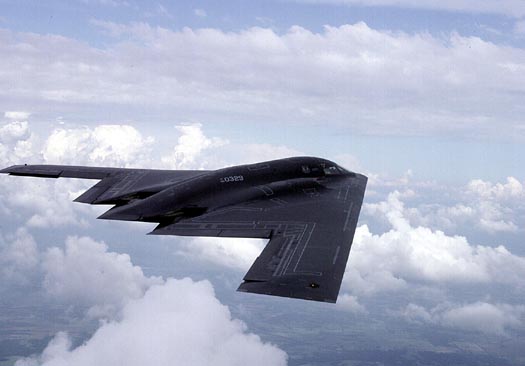
USAF Photo by MSgt. Rose Reynolds

USAF Photo by MSgt. Rose Reynolds
The B-2 Spirit is a multi-role bomber capable of delivering both
conventional and nuclear munitions. A dramatic leap forward in technology, the
bomber represents a major milestone in the U.S. bomber modernization program.
The B-2 brings massive firepower to bear, in a short time, anywhere on the globe
through previously impenetrable defenses.
Along with the B-52 and B-1B, the B-2 provides the penetrating
flexibility and effectiveness inherent in manned bombers. Its low-observable, or
"stealth," characteristics give it the unique ability to penetrate an
enemy's most sophisticated defenses and threaten its most valued, and heavily
defended, targets. Its capability to penetrate air defenses and threaten
effective retaliation provide a strong, effective deterrent and combat force
well into the 21st century.
The revolutionary blending of low-observable technologies with high
aerodynamic efficiency and large payload gives the B-2 important advantages over
existing bombers. Its low-observability provides it greater freedom of action at
high altitudes, thus increasing its range and a better field of view for the
aircraft's sensors. Its unrefueled range is approximately 6,000 nautical miles
(9,600 kilometers).
The B-2's low observability is derived from a combination of reduced
infrared, acoustic, electromagnetic, visual and radar signatures. These
signatures make it difficult for the sophisticated defensive systems to detect,
track and engage the B-2. Many aspects of the low-observability process remain
classified; however, the B-2's composite materials, special coatings and
flying-wing design all contribute to its "stealthiness."
The B-2 has a crew of two pilots, a pilot in the left seat and mission
commander in the right, compared to the B-1B's crew of four and the B-52's crew
of five.
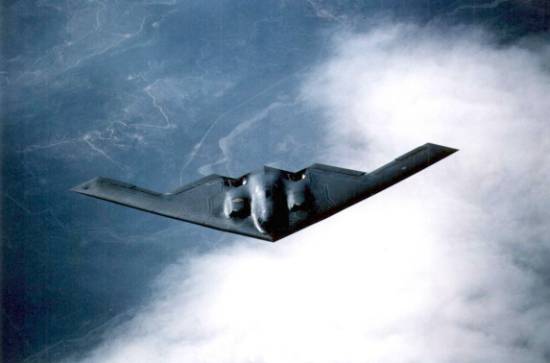
The first B-2 was publicly displayed on Nov. 22, 1988, when it was rolled
out of its hangar at Air Force Plant 42, Palmdale, Calif. Its first flight was
July 17, 1989. The B-2 Combined Test Force, Air Force Flight Test Center,
Edwards Air Force Base, Calif., is responsible for flight testing the
engineering, manufacturing and development aircraft as they are produced.
Whiteman AFB, Mo., is the B-2's only operational base. The first
aircraft, Spirit of Missouri, was delivered Dec. 17, 1993. Depot maintenance
responsibility for the B-2 is performed by Air Force contractor support and is
managed at the Oklahoma City Air Logistics Center at Tinker AFB, Okla.
The prime contractor, responsible for overall system design and
integration, is Northrop Grumman's Military Aircraft Systems Division. Boeing
Military Airplanes Co., Hughes Radar Systems Group and General Electric Aircraft
Engine Group are key members of the aircraft contractor team. Another major
contractor, responsible for aircrew training devices (weapon system trainer and
mission trainer) is Hughes Training Inc. (HTI) - Link Division, formerly known
as CAE - Link Flight Simulation Corp. Northrop Grumman and its major
subcontractor HTI, are responsible for developing and integrating all aircrew
and maintenance training programs.
Primary
function: Multi-role
heavy bomber.
Prime Contractor: Northrop Grumman Corp.
Contractor Team: Boeing Military Airplanes Co., General Electric Aircraft
Engine Group and Hughes Training Inc., Link Division
Power Plant: Four General Electric F-118-GE-100 engines
Thrust: 17,300 pounds each engine
Length: 69 feet (20.9 meters)
Height: 17 feet (5.1 meters)
Wingspan: 172 feet (52.12 meters)
Speed: High subsonic
Ceiling: 50,000 feet (15,152 meters)
Takeoff Weight (Typical): 336,500 pounds (152,635 kilograms)
Range: Intercontinental, unrefueled
Armament: Conventional or nuclear weapons
Payload: 40,000 pounds (18,144 kilograms)
Crew: Two pilots
Unit cost: Approximately $1.3 billion
Date Deployed: December 1993
Inventory: Active force: 21 (planned operational aircraft); ANG: 0;
Reserve: 0
.
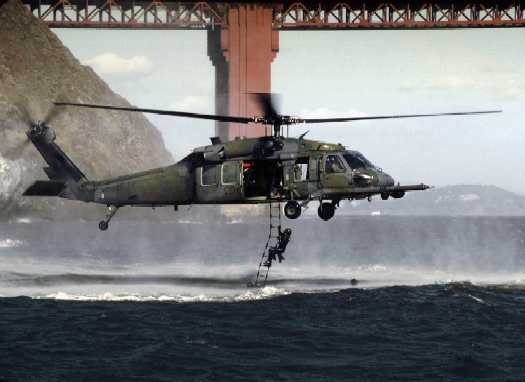
The primary mission of the HH-60G Pave Hawk helicopter is to conduct day
or night operations into hostile environments to recover downed aircrew or other
isolated personnel during war. Because of its versatility, the HH-60G is also
tasked to perform military operations other than war. These tasks include civil
search and rescue, emergency aeromedical evacuation (MEDEVAC), disaster relief,
international aid, counterdrug activities and NASA space shuttle support.
The Pave Hawk is a highly modified version of the Army Black Hawk
helicopter which features an upgraded communications and navigation suite that
includes an integrated inertial navigation/global positioning/Doppler navigation
systems, satellite communications, secure voice, and Have Quick communications.
All HH-60Gs have an automatic flight control system, night vision goggles
lighting and forward looking infrared system that greatly enhances night
low-level operations. Additionally, Pave Hawks have color weather radar and an
engine/rotor blade anti-ice system that gives the HH-60G an all-weather
capability.
Pave Hawk mission equipment includes a retractable in-flight refueling
probe, internal auxiliary fuel tanks, two crew-served 7.62mm machineguns and an
8,000-pound (3,600 kilograms) capacity cargo hook. To improve air
transportability and shipboard operations, all HH-60G's have folding rotor
blades.
Pave Hawk combat enhancements include a radar warning receiver, infrared
jammer and a flare/chaff countermeasure dispensing system.
HH-60G rescue equipment includes a hoist capable of lifting a 600 pound
load (270 kilograms) load from a hover height of 200 feet (60.7 meters), and a
personnel locating system that is compatible with the PRO-112 survival radio and
provides range and bearing information to a survivor's location.
A limited number of Pave Hawks are equipped with an over-the-horizon
tactical data receiver that is capable of receiving near real-time mission
update information.
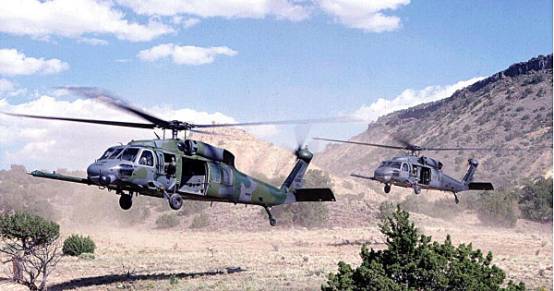
The Pave Hawk is a twin-engine medium-lift helicopter operated by Air
Combat Command, Pacific Air Forces, Air Education and Training Command, Air
National Guard and Air Force Reserve Command.
During Operation Desert Storm Pave Hawks provided combat search and
rescue coverage for coalition Air Forces in western Iraq, Saudi Arabia, coastal
Kuwait and the Persian Gulf. They also provided emergency evacuation coverage
for U.S. Navy sea, air and land (SEAL) teams penetrating the Kuwaiti coast
before the invasion.
During Operation Allied Force, the Pave Hawk provided continuous combat
search and rescue coverage for NATO air forces, and successfully recovered two
Air Force pilots who were isolated behind enemy lines.
In March 2000, three Pave Hawks deployed to Mozambique, Africa, to
support international flood relief operations. The HH-60s flew 240 missions in
17 days and delivered more than 160 tons of humanitarian relief supplies.
Primary
Function: combat
search and rescue and military operations other than war in day, night or
marginal weather conditions.
Builder: United Technologies/Sikorsky Aircraft Company
Power Plant: Two General Electric T700-GE-700 or T700-GE-701C
engines
Thrust: 1,560-1,630 shaft horsepower, each engine
Length: 64 feet, 8 inches (17.1 meters)
Height: 16 feet, 8 inches (4.4 meters)
Rotary Diameter: 53 feet, 7 inches (14.1 meters)
Speed: 184 mph (294.4 kph)
Maximum Takeoff Weight: 22,000 pounds (9,900 kilograms)
Range: 445 statute miles; 504 nautical miles (unlimited with
air refueling)
Armament: Two 7.62mm machineguns
Unit Cost: $10.1 million (1992 dollars)
Crew: Two pilots, one flight engineer and one gunner
Date Deployed: 1982
Inventory: Active force, 64; ANG, 18; Reserve, 23.
[Other versions are
the UH-60 Black Hawk (Army); HH-60H (Navy); MH-60G
Pave Hawk
(Air Force); HH-60J Jayhawk (Coast Guard).]
Used in:
Navy, Army, Air Force, Coast Guard
Description:
A twin-engine, medium lift, utility or assault helicopter.
Features:
The Seahawk is a twin-engine helicopter. It is used for anti-submarine
warfare, search and rescue, drug interdiction, anti-ship warfare, cargo lift,
and special operations. The Navy's SH-60B Seahawk is an airborne platform
based aboard cruisers, destroyers, and frigates and deploys sonobouys (sonic
detectors) and torpedoes in an anti-submarine role.
They also extend the range of the ship's radar capabilities. The Navy's SH-60F
is carrier-based. Some versions, such as the Air Force's MH-60 G Pave
Hawk and the Coast Guard's HH-60J Jayhawk, are equipped
with a rescue hoist with a 250 foot (75 meter) cable that has a 600 pound (270
kg) lift capability, and a retractable in-flight refueling probe. The Army's
UH-60L Black Hawk can carry 11 soldiers or 2,600 pounds (1,170 kg) of
cargo or sling load 9,000 pounds (4,050 kg) of cargo.
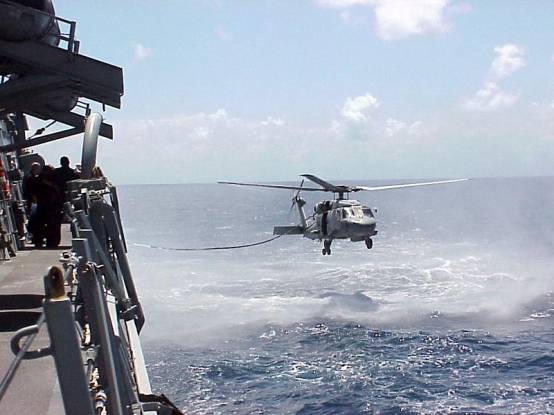
Background:
The UH-60 Black Hawk was fielded by the Army in 1979. The Navy received
the SH- 60B Seahawk in 1983 and the SH-60F in 1988. The Air Force
received the MH-60G Pave Hawk in 1982 while the Coast Guard received the
HH-60J Jayhawk in 1992. The unit cost varies with the version. For
example, the unit cost of the Army's UH-60L Black Hawk is $5.9 million
while the unit cost of the Air Force MH-60G Pave
Hawk is $10.2 million